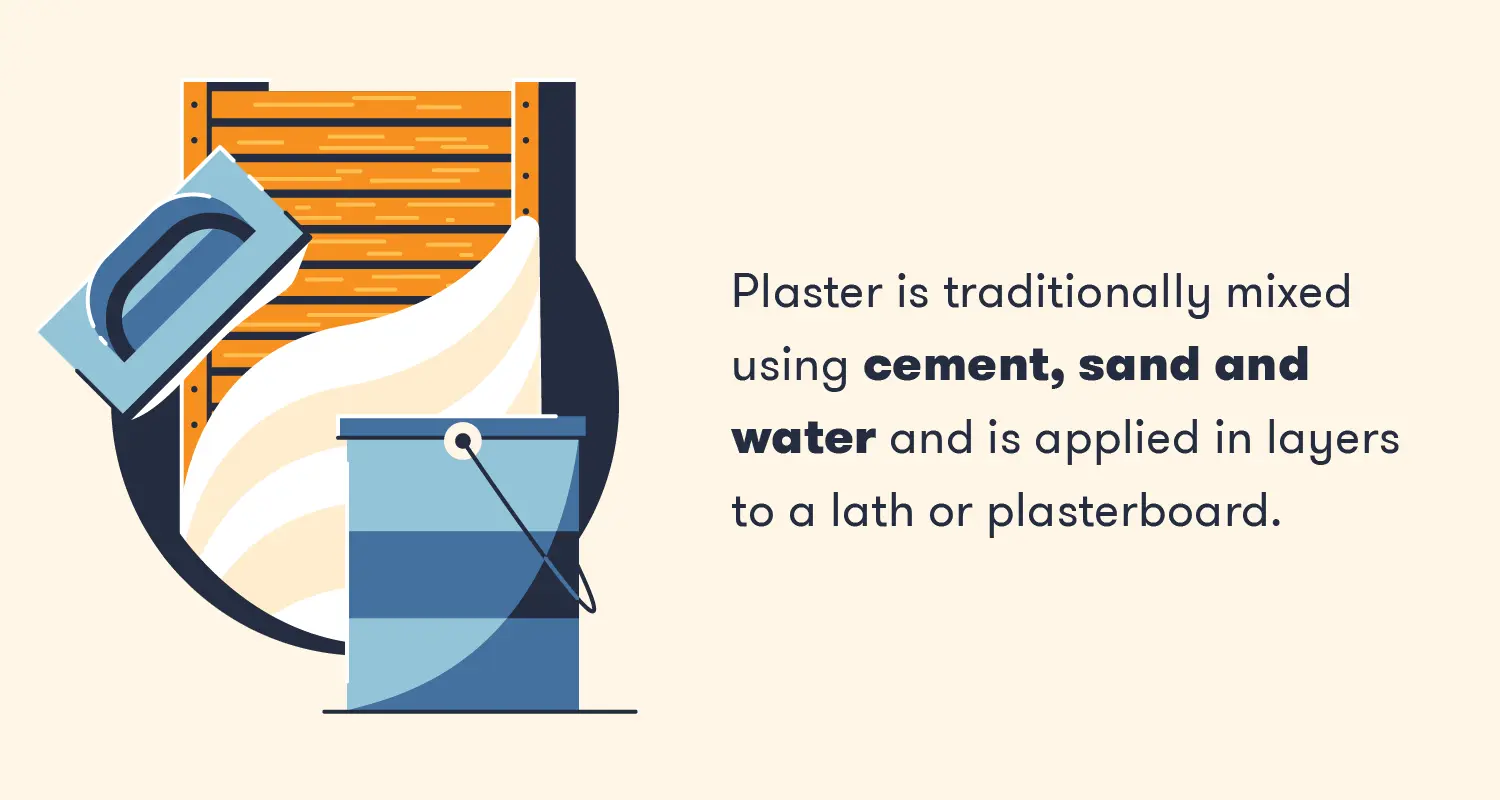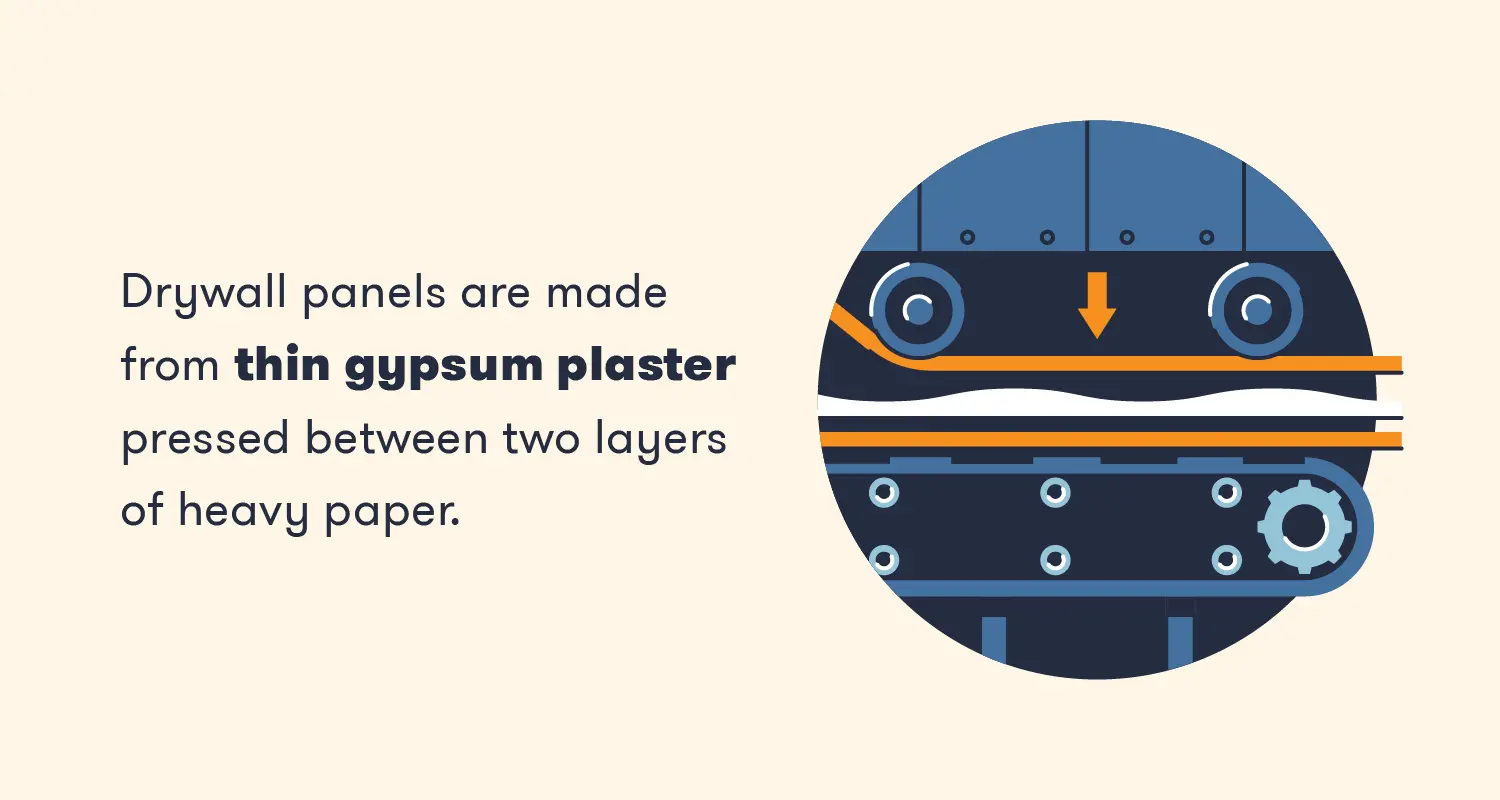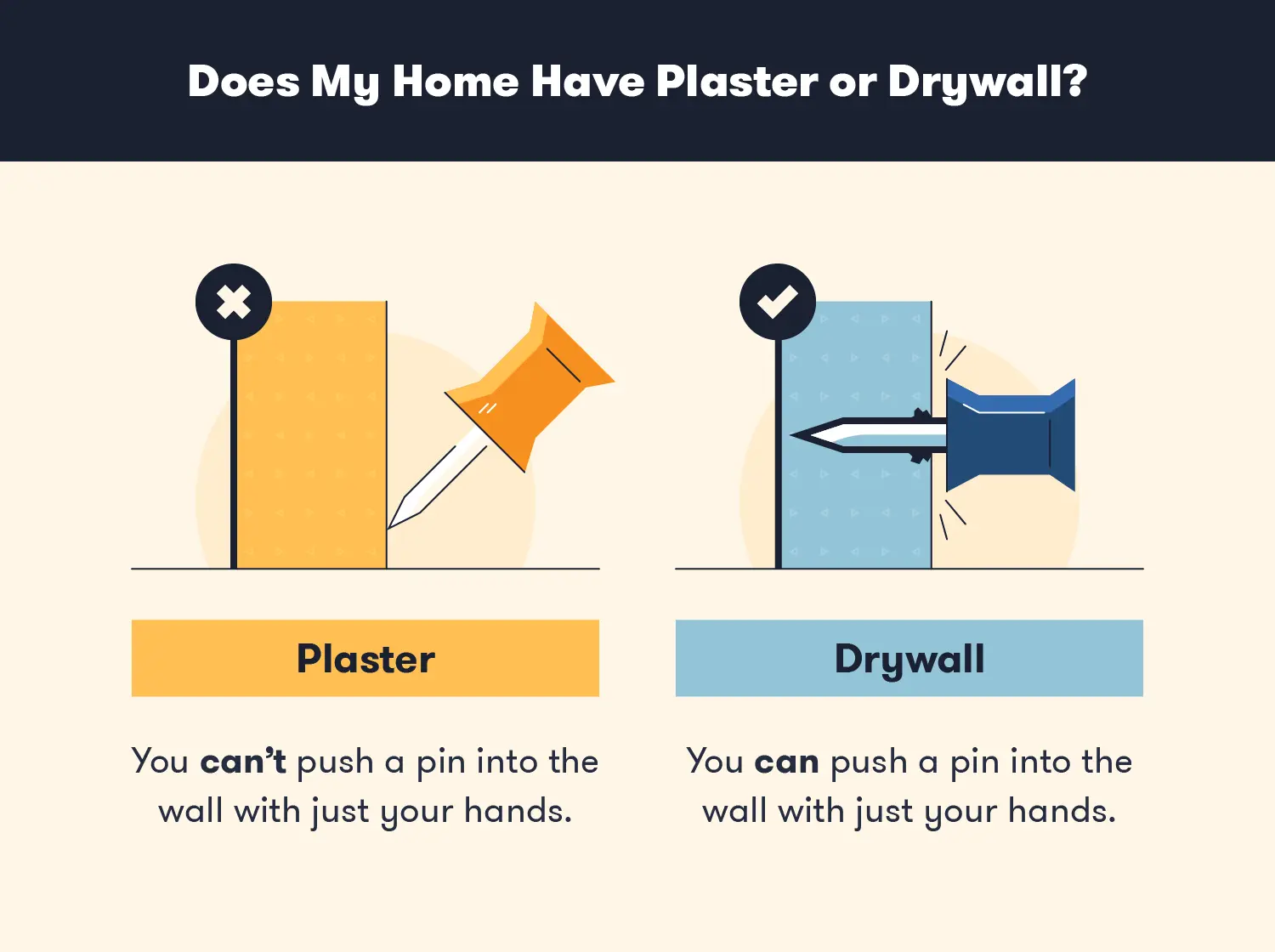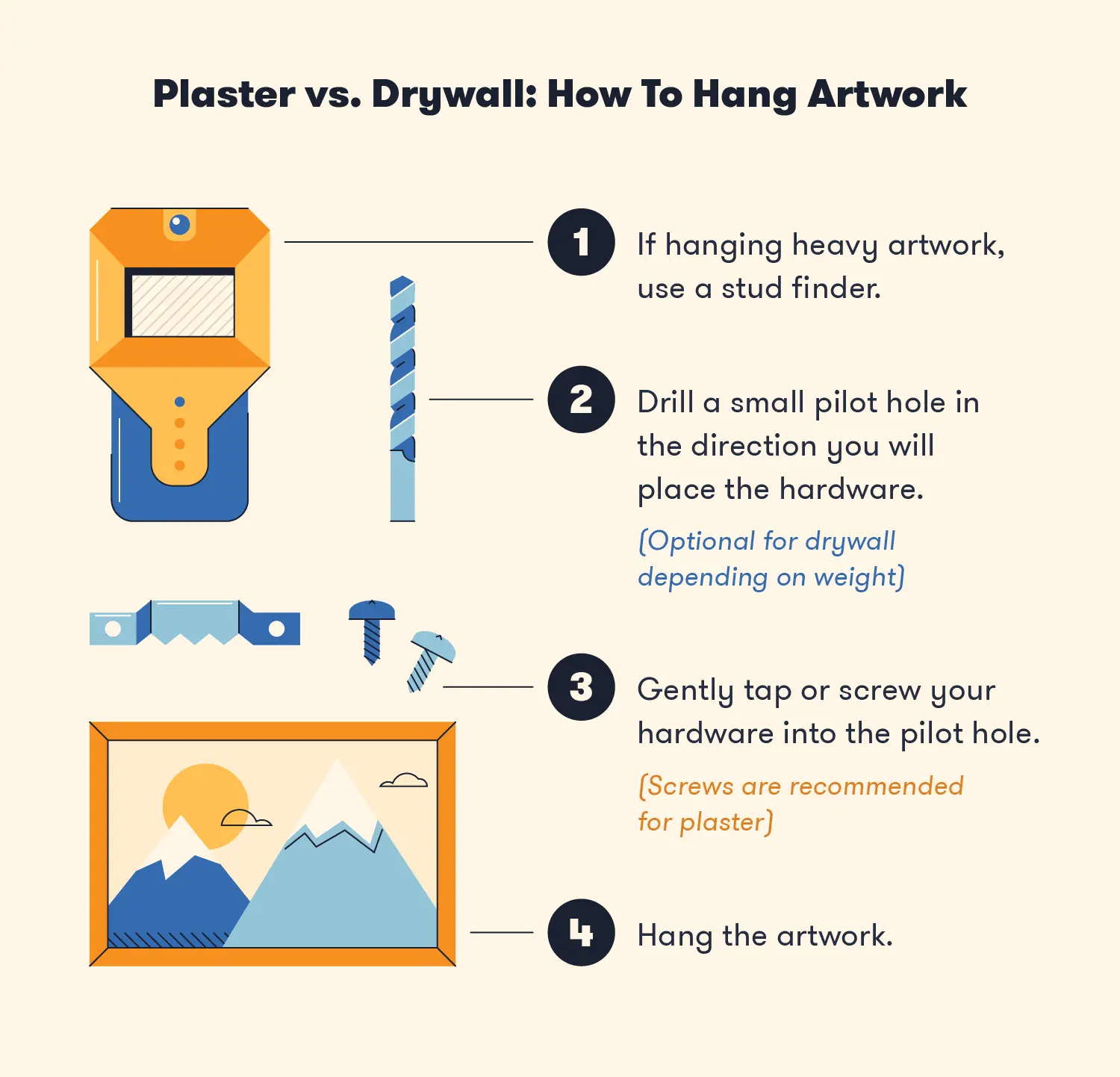Plaster and drywall are popular options when choosing an interior wall finish. They’re commonly found in both residential and commercial buildings, and they each have distinct features that set them apart.
If you’re embarking on an interior construction or remodeling project, there are plenty of factors to consider when choosing a finishing option for your space. To help you decide, we’ll explain the critical differences between plaster and drywall and go over the pros and cons of each option.
Table of Contents
- Plaster vs. Drywall: Overview of Key Factors
- What Is Plaster?
- What Is Drywall?
- How To Tell Drywall vs. Plaster
- Plaster vs. Drywall: Detailed Comparison
- Cost
- Durability
- Installation Time
- Soundproofing
- Insulation
- Energy Efficiency
- Repairs
- Fire Resistance
- Look and Finish
- Hanging Decor
- FAQ About Plaster and Drywall
Plaster vs. Drywall: Overview of Key Factors
While plaster and drywall contain some of the same components, they each have advantages and disadvantages that make them better suited for specific projects. Before you choose one over the other, consider the following factors that set them apart.
| Plaster | Drywall | Best Option | |
| Cost | Costs $2 to $10 per square foot to install | Costs $1 to $3 per square foot to install | Drywall |
| Durability | Very hard, dense and long-lasting | Thin panels offer low durability | Plaster |
| Installation Time | Can take weeks to install and dry | Precut panels take just a few days to hang | Drywall |
| Soundproofing | High-density material blocks and muffles sound | Thin panels allow sound to pass through easily | Plaster |
| Insulation | Difficult and costly to add insulation | Easy to add high-quality insulation | Drywall |
| Energy Efficiency | Difficult to insulate in cold climates | Added insulation lowers energy usage | Drywall |
| Repairs | Repairs can be costly and time-consuming | Easy to patch holes or replace panels | Drywall |
| Fire Resistance | Offers natural fire resistance and protects wood framing | Thin, fire-resistant later can break down when exposed to high heat | Plaster |
| Look and Finish | Achieves a more polished look and is less prone to damage | Difficult to achieve a smooth finish and is easily damaged | Plaster |
| Hanging Decor | More difficult (but not impossible) to hang items | Easier to hang items | Drywall |
What Is Plaster?
Builders have used plaster for interior walls for centuries. If you walk into a residential building built before 1950, you’ll likely find plaster walls and ceilings. Its popularity stemmed from its durability and ability to easily cover a variety of materials, including brick, wood and stone.
Plaster is traditionally mixed using cement, sand and water and can contain materials like granite silicone or gypsum. To install it, a professional applies the mix to a previously installed plasterboard or lath in layers, then waits for it to bond to the surface as it dries. Once dry, it can be sanded over and painted to achieve the desired look.

Pros:
- Long-lasting
- Fire resistant
- Muffles sound
- Easy to achieve a polished finish
Cons:
- High cost
- Long installation times
- Difficult to repair
- Difficult to repair
What Is Drywall?
Drywall emerged as a new alternative to plaster during the mid-20th century and is now commonplace in buildings across the globe. Drywall panels consist of gypsum plaster pressed between two layers of heavy paper, which can be cut to size to accommodate doorways, windows and electrical outlets. Because the space behind each panel can easily accommodate insulation, this finish is a popular choice in colder climates.
To secure the panels to the structure, professionals use nails, screws or specialized drywall fasteners. Once the panels are secure, they conceal any exposed fastener heads and joints with tape and a pliable drywall compound and allow it to dry. The final product can then be covered with paint or a finishing compound to achieve a more finished look.

Pros:
- Quick installation
- Low cost
- Easily accommodates insulation
- Easy to repair
Cons:
- Low durability
- Sound passes through easily
- Leaks can cause mold to grow behind panels
- Leaks can cause mold to grow behind panels
How To Tell Drywall vs. Plaster
If you’d like to know whether your home has plaster or drywall, it’s fairly easy to tell. Here are a few tips to help you figure out what you have.
Your Home’s Age
Drywall didn’t become popular in residential construction until around the 1950s, and it didn’t really kick off until after the 1960s. This means your home’s age can be a telling factor when trying to know whether your walls are plaster or drywall.
- Homes built before 1950 probably have plaster.
- Homes built between 1950 – 1969 might be plaster or drywall.
- Homes built after 1970 are probably drywall.
Cracks and Flaking Paint
If you don’t see any cracks or flaking paint in your home, that’s a good sign you may have drywall. Drywall doesn’t usually crack. If it does, it’s in smaller areas and often around joint seams.
Plaster, on the other hand, is more prone to cracking. When it does crack, it’s more likely to crack in larger areas, with multiple smaller cracks breaking off a larger one. It is also more likely to feature flaking paint.
The Pushpin Test
If you’re still not sure, try the pushpin test. This is a fail-safe method that will quickly tell you what materials make up your wall. All you need to do is take a simple thumbtack and try to push it through your walls.

If the pushpin penetrates the wall, you have drywall. If it doesn’t, you have plaster. Pushpins will not penetrate a plaster wall without a hammer or some other extra force. However, it’s not wise to use a hammer on plaster as it may crack the wall, so don’t try this if you’re unable to push the pin through the wall with just your hands.
Now that you know what type of wall you have in your home, don’t forget to check out our tips for hanging items on plaster vs. drywall!
Plaster vs. Drywall: Detailed Comparisons
If you’re undertaking a new construction project and can’t decide which material is best for your project, take a look at our detailed feature comparison below.
Cost
If you’re looking for a budget-friendly option, drywall could be the way to go. Installing drywall costs around $1 to $3 per square foot, and amateur builders may be able to avoid hiring a professional by installing it themselves.
Plaster requires a more specialized skill set and takes more time to install than drywall, making it significantly more expensive. Installation can cost anywhere from $2 to $10 per square foot, and you’ll need to hire a professional to ensure that it is installed correctly.
Most cost-effective: Drywall
Durability
Plaster is hard and dense, making it the better option for those looking for a durable finish. The layers form a solid mass once they’ve dried, and plaster walls can often hold up for decades without needing to be replaced. That said, it can be harder to hang pictures or art on a plaster wall because they are so solid. Nails can crack and chip plaster, so it’s best to use adhesive or screws if you want to hang wall art.
Drywall sheets have an open cavity behind them and are much less dense than plaster. This leaves them susceptible to damage and mold buildup, and they may need more frequent repairs. However, drywall may be the best option if you want to decorate your walls using nails or pins. Hammering or pushing nails into drywall is relatively easy and should only leave a small hole behind.
Most durable: Plaster
Installation Time
Because the sheets are precut, an experienced crew can install drywall for an entire house in just a few days. Quick and easy installation makes drywall a popular option for larger buildings and projects running on a tight schedule.
Installing plaster comes with a few extra steps, and rushing it could lead to irreversible mistakes. If you choose to install plaster finishes in your building, expect to set aside a few weeks for installation and around 3-5 days of drying time.
Shortest installation time: Drywall
Soundproofing
Plaster walls are significantly better at dampening sound than standard drywall. Plaster is very dense and lacks hollow spaces, making it difficult for sound waves to pass through it. Its sound-dampening qualities make it a good option for multiunit buildings, and it can add privacy to rooms in family homes.
Drywall panels, on the other hand, are fairly thin and have an empty space behind them, allowing sound to pass through easily. If you want to create a soundproof space without using traditional plaster, you should consider adding special acoustic plasterboard or fiberglass insulation behind your drywall to help muffle sound.
Most soundproof: Plaster
Insulation
Drywall on its own is too thin to insulate a structure, but the space behind it is the optimal place to add insulation. Fiberglass batts and spray foam are the most common types of insulation people use, and they are easy to add when installing or replacing drywall. Loose-fit cellulose is also an option for people who want to add insulation without removing the drywall panels.
Plaster is a better insulator on its own, but it can be difficult to add insulation to existing plaster walls. This can be a problem for owners of older homes built before central heating and cooling systems were commonplace. If you want to insulate existing plaster walls, you’ll need a professional to retrofit the structure to accommodate insulation. Attempting to do this on your own could damage the walls and allow mold and water to get into them.
Best for adding insulation: Drywall
Energy Efficiency
There is some debate over which finishing method is more eco-friendly, but drywall wins out when it comes to a building’s overall energy use. When used with quality insulation, drywall reduces the energy needed to keep a structure at the desired temperature. A skilled drywall contractor can also use sealants and a specialized hanging method to create an airtight barrier that minimizes air leaks.
Plaster may not be as energy-efficient as drywall, but it has some environmental benefits to consider. Plaster generally lasts much longer than drywall and doesn’t need to be replaced as often. This helps minimize construction waste and reduces the materials required for repairs. In warmer climates, plaster made from recycled materials can also help keep buildings cool and absorb humidity, reducing the need for air conditioning.
Most energy-efficient: Drywall
Repairs
Drywall is less durable than plaster but is generally easier to repair. Store-bought drywall repair kits can cover small holes, cracks and chips, and most hardware stores sell drywall patches for mid-sized holes. If a large section of drywall has water damage or large holes, you can easily replace individual panels.
You can quickly repair minor chips, cracks and uneven areas in plaster walls with a plaster repair kit, but you’ll need professional help for significant damages. Deep or map cracking requires a multistep process to repair, and plaster that has deteriorated beyond repair may need to be replaced altogether. If you’re unsure how to handle plaster damage, it’s best to call a professional.
Easiest to repair: Drywall
Fire Resistance
While no wall containing wood framing is entirely fireproof, plaster offers an additional layer of protection that can help slow fire spread. Plaster contains gypsum, which has a high water content and doesn’t burn. Builders have also begun using metal laths or plasterboard backing instead of wooden laths to support plaster, reducing the risk of rapid fire spread.
Drywall also contains gypsum and adds a fire-resistant barrier on top of wood framing. However, it can lose its structural integrity faster than plaster when exposed to high heat, so some manufacturers add noncombustible glass fibers to their drywall mixtures to boost its integrity.
Most fire-resistant: Plaster
Look and Finish
One of the most apparent differences between plaster and drywall is the visual appeal. Plaster can typically achieve a more polished look than drywall and is less prone to dents and holes. If you are looking for a glossy, smooth or stucco-like finish, professionals can easily apply the desired texture with plaster. Plaster is also the best choice for curved walls or ceilings since drywall is very difficult to bend.
Drywall may look less polished than plaster, but there are still plenty of design options to choose from. Orange peel is a commonly used drywall texture with a slightly bumpy or wrinkled look, and professionals can use towels or brushes to create a variety of designs. A smooth drywall finish is possible, but it’s less common since it’s more challenging to apply.
Most appealing finish: Plaster
Hanging Décor
Hanging picture frames and other home décor tends to be easier on drywall because it is a softer material. Plaster is harder and more brittle, so trying to install hanging hardware might lead to cracks or other damage if you aren’t careful.

When hanging items on drywall, make sure the weight rating of the hardware you use is appropriate for the weight of the item you’d like to hang. For heavier items, consider placing a nail or screw in a stud of your wall.
For hanging items on plaster, opt for hardware with screws. Using a hammer to hang items on drywall is not recommended because cracking is a high risk. If you do plan to use a nail and hammer, always pre-drill a pilot hole in plaster walls to avoid cracks.
Easiest to hang items: Drywall
FAQ About Plaster and Drywall
Have other questions about plaster compared to drywall? Here are answers to some common questions.
Is Plaster Better than Drywall?
Plaster and drywall both come with their own pros and cons. Plaster tends to be better than drywall in the following ways:
- It’s longer-lasting
- It’s fire resistant
- It muffles sound better
- It’s easier to achieve a polished finish
However, plaster also tends to come with a higher cost, and it’s more difficult to install insulation with plaster walls. So, if you live in a colder climate, drywall may be better. However, if you’re making a sound studio in your home, plaster may be better.
Is Plaster the Same as Drywall?
While plaster and drywall are both materials used to finish walls in residential and commercial buildings, they aren’t exactly the same thing. Plaster is a stronger material with better soundproofing capabilities. Drywall is thinner but tends to provide better insulation options.
Is Plaster Flammable?
Plaster is fire resistant. Depending on what plaster walls contain, it can withstand temperatures up to 650 ℃ (1200 ℉) for up to two hours.
When choosing a wall finish for your building, it’s important to consider the pros and cons of each option. Plaster offers better quality, fireproofing and soundproofing, while drywall generally costs less and allows for better insulation.
If you’re ready to install your new plaster or drywall finishes, be sure to rent quality equipment or reach out to a professional if you need additional advice.

table.comparison{border-collapse:collapse;border-spacing:0;empty-cells:show;font-size:1rem;width:100%;margin-bottom:1.25rem}table.comparison td,table.comparison th{padding:2%;margin:0;line-height:1.25rem;color:#4471a0;text-align:center}table.comparison thead{vertical-align:bottom;white-space:normal}table.comparison thead td{background:#356bb0;color:#fff;font-weight:600;text-align:center}table.comparison th{font-weight:bold;text-align:left}table.comparison thead td{background:#4471a0;font-size:20px;padding:35px 0}table.comparison td{padding:25px 10px;font-size:16px;line-height:1.625}table.comparison tbody td{border:none}.news-article-body table tbody > tr:nth-child(even) > td{background:#fff6e6}table.comparison tbody tr td:first-child{background-color:#F79020;color:#fff;text-align:left;font-weight:500;font-size:18px}table.comparison ul{list-style-type:none;text-align:center;margin:0}table.comparison li{padding-bottom:0.5em;line-height:1.4}table.comparison li:last-child{padding-bottom:0}